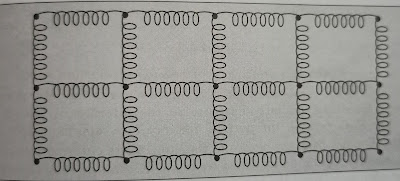RADIOACTIVITY
Radioactivity:
The uranium salt emitted the rays spontaneously.The phenomenon of spontaneous emission of radiations by heavy elements is called Radioactivity .Properties of nuclear radiation:
1. Properties of Alpha(α) rays:
- Alpha(α) particles is a helium nucleus consisting of two protons and two neutrons.
- The velocity of α- particles ranges from 1.4 x 10^7 m/s to 2.05 x 10^7 m/s.
-They are deflected by electric and magnetic fields.
- Alpha (α) particles produce fluorescence in substance like zinc sulphide and barium platinocyanide.
- They are massive particles and hence easily stopped by an aluminium sheet of only 0.02mm thick or even by ordinary sheet of paper.
- They have great ionising power. Each α-particles produces thousands of ions pairs in a gas before being absorbed.
- They get scattered while passing through this metal foils.
- They affect a photographic plate.
- They can produce artificial radioactivity in certain elements and can produce nuclear reaction.
- The range of α- particles,at normal pressure in air varies from 3 cm to 8 cm depending on initial kinetic energy of the particle.
2.PROPERTIES OF BETA (β)RAYS:
- Beta (β) particles are fast moving electrons.
- The velocity of (β) particles ranges from 33% to 99.8% of velocity of light.
- They can produce ionisation in gas but their ionising in gas but their ionising power is 1/100 of that of α- particles .
- They have penetration power more than α-particles.
- They can affect a photographic plate.
- They can produce fluorescence in material like zinc sulphide and barium plantinocyanide.
- They are deflected by electric and magnetic fields.
- The ranges of β- particles in air is several metres.
- They can produce artificial radioactivity.
3. PROPERTIES OF GAMMA(γ) RAYS.
- γ-rays are electromagnetic waves having velocity equal to velocity of light.
- γ-rays are highly penetrating. They can penetrate through several metres of thick iron and lead blocks . Their penetrating power is 100 times that of β-particles.
- They have small ionising power. Their ionising power is about1/100 of that of β-particles.
- They affect the photographic plate.
- They are not deflected by electric and magnetic fields.
- They can produce fluorescence in fluorescent material.
- They knock out electrons from the surface of a metal on which they fall.
- γ-rays produce heating effect in the surface exposed to them.
- γ-rays can produce nuclear reaction.
- In hospital , hard rays used in radio-therapy.


Comments
Post a Comment